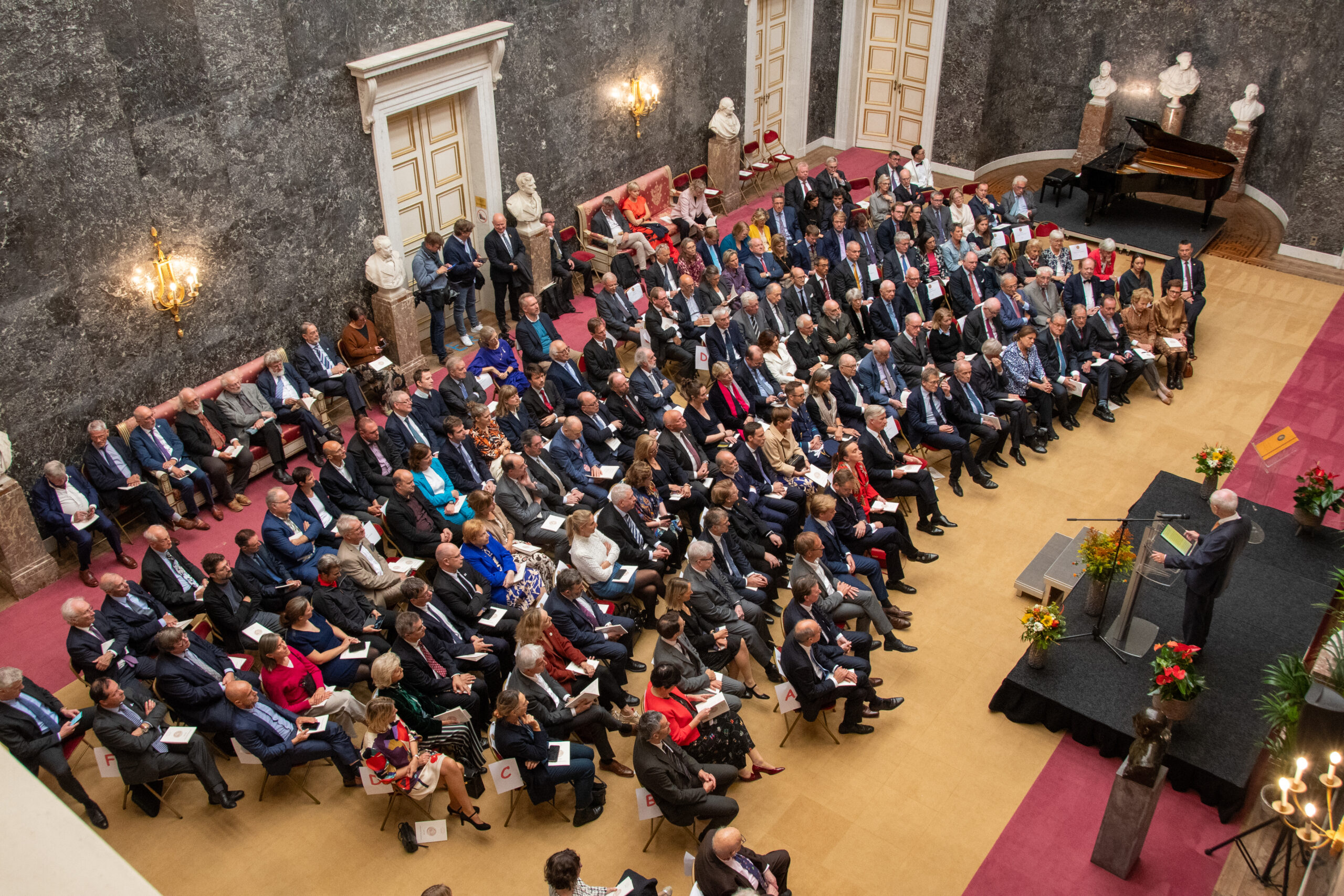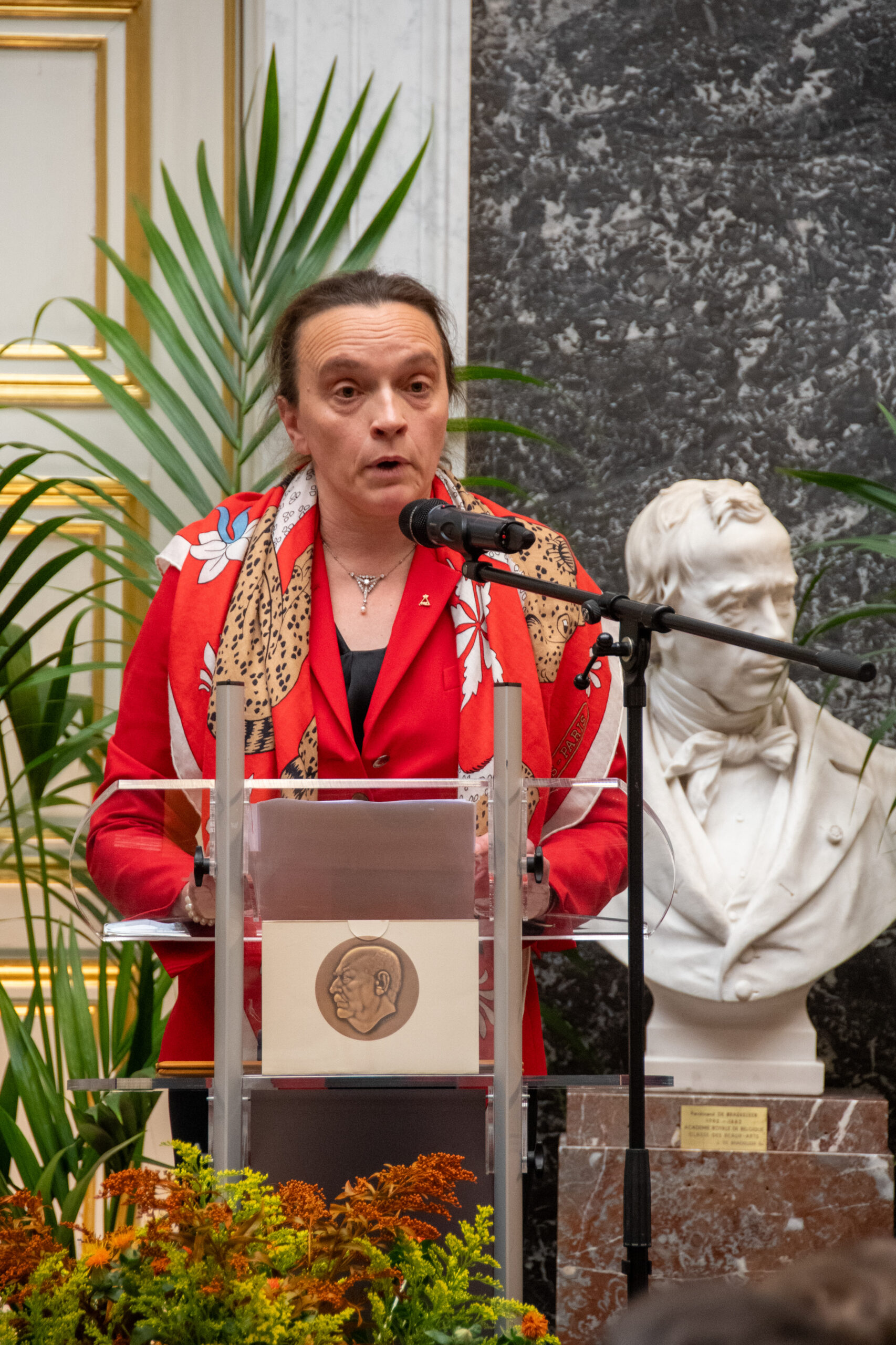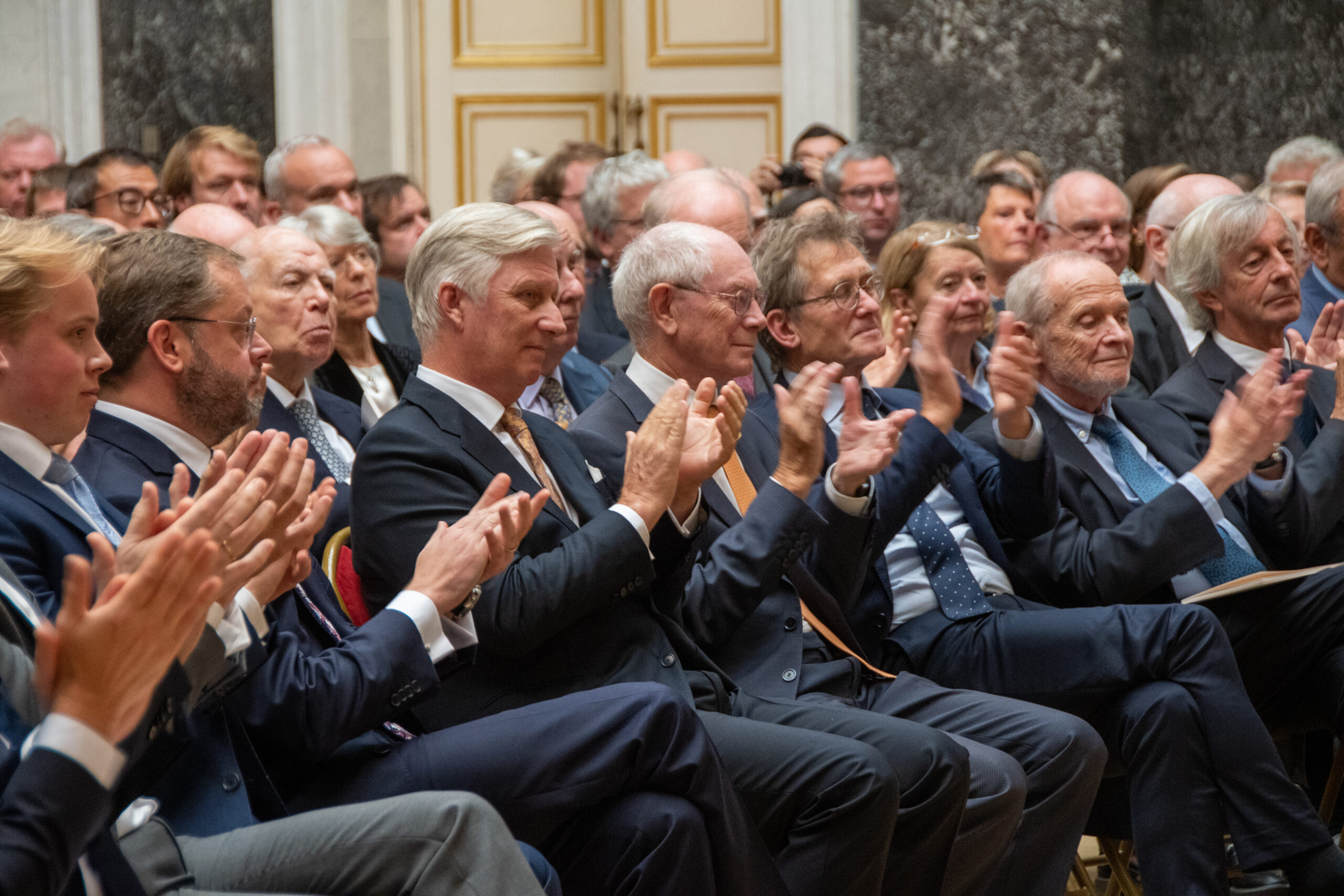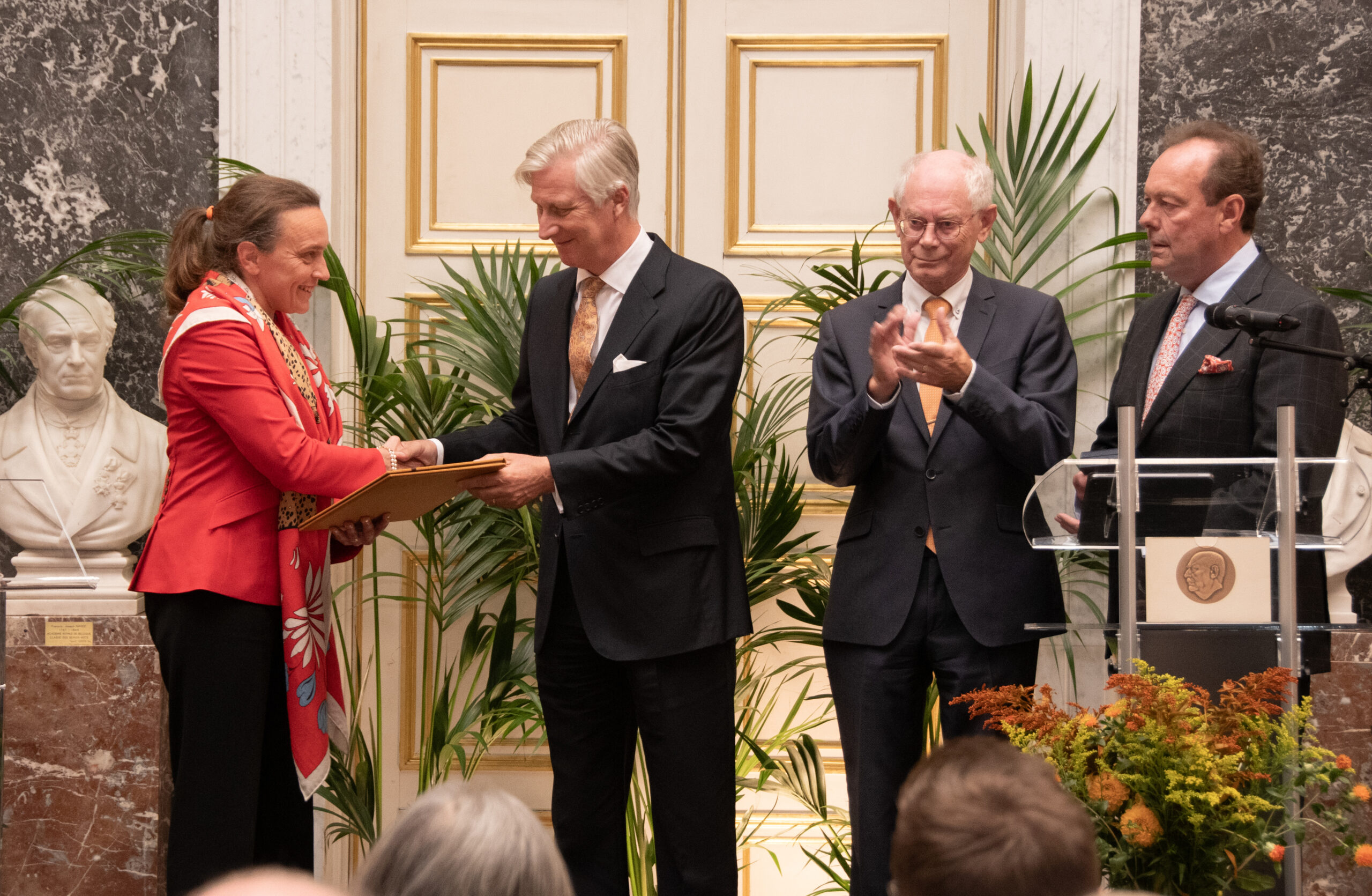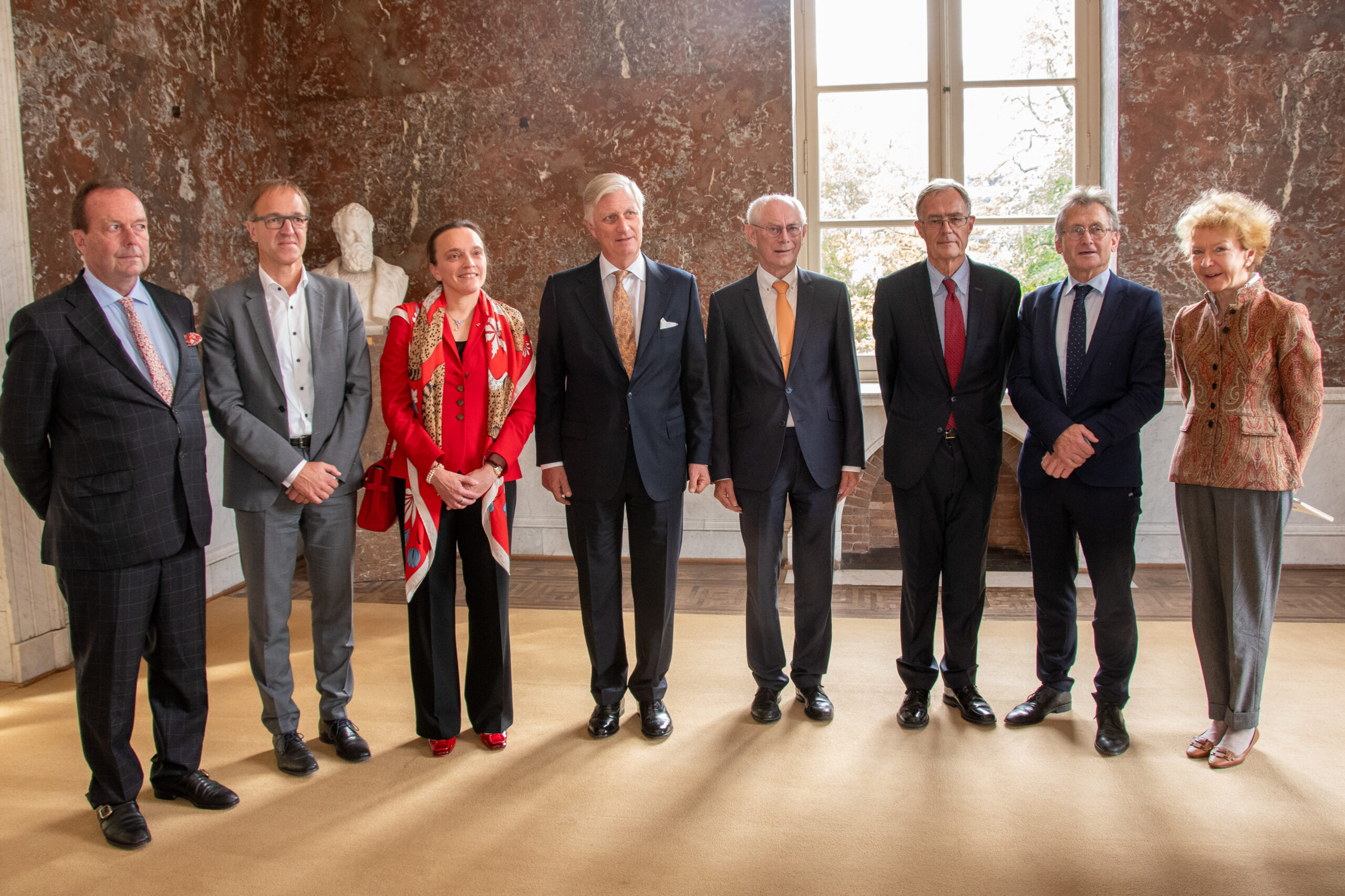2024 Veronique VAN SPEYBROECK
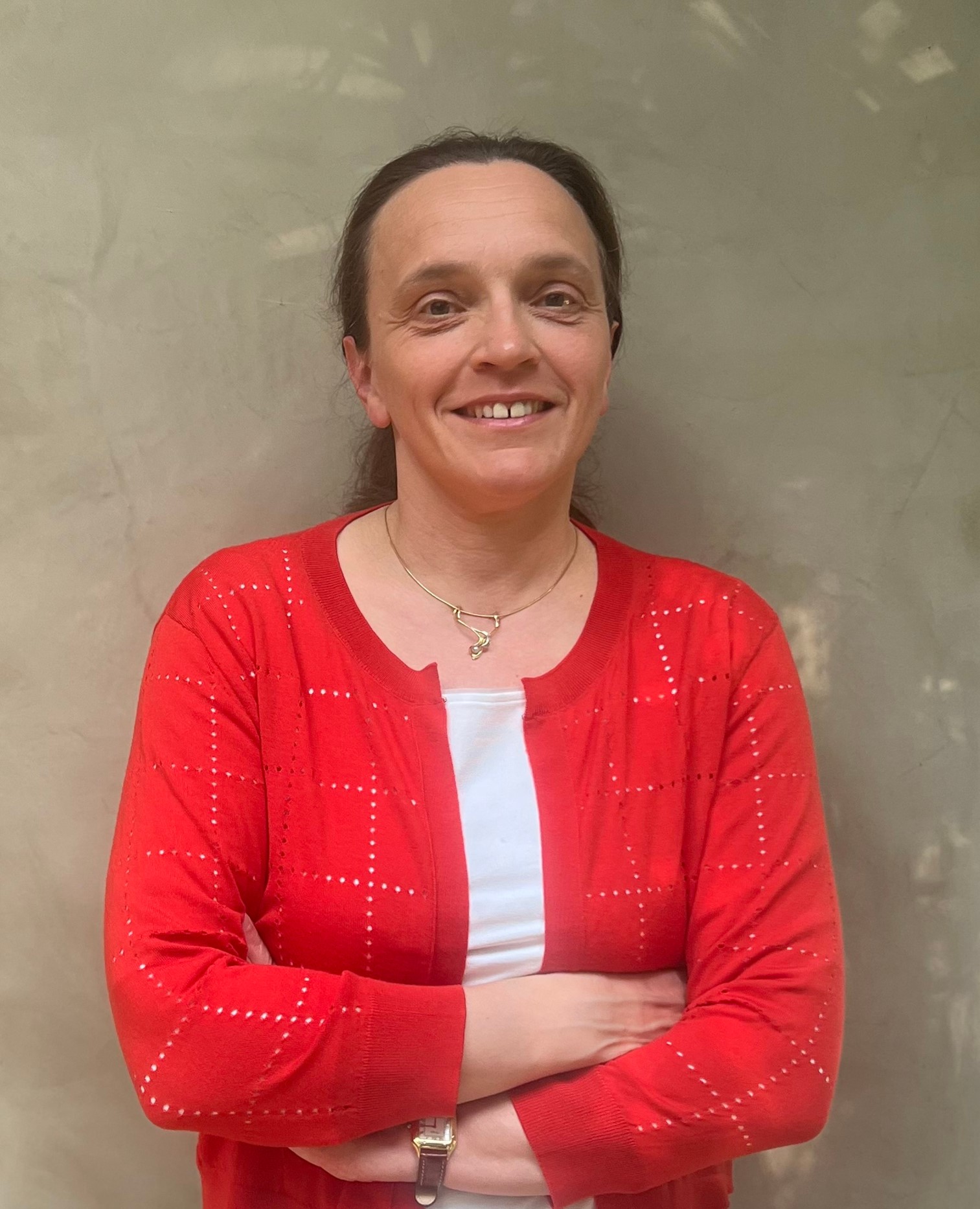
Veronique VAN SPEYBROECK
Exact Sciences – Applied Physics
Gewoon Hoogleraar, Vakgroep Toegepaste Fysica,
Centrum voor Moleculaire Modellering
Universiteit Gent
Career – Research – Jury report
Her career
Veronique was born in 1974 in Ghent as the youngest daughter in a family of three children. After studying science and mathematics in secondary school, she started her studies in Civil Engineering at Ghent University. Given her fascination with highly theoretical subjects, she chose for Engineering physics. When she first came into contact with the field of quantum mechanics, she becomes very fascinated by this abstract theory. She follows the course “Quantum Theory of Chemical Bonding” and becomes very much intrigued by the fact that the abstract theory of quantum mechanics allows to describe the behavior of molecules. In her Master’s thesis she investigates how Density Functional Theory can be applied to molecular systems. She conducts this research at the Institute for Nuclear Sciences under the supervision of Prof. Michel Waroquier, who until then worked in the field of many-body techniques applied to nuclear systems. The application of these techniques to molecular systems was unexplored territory at Ghent University.
Immediately after graduating as an Engineer in Physics in 1997, she decided to perform a research internship at DSM Research in Geleen in the Netherlands on the Car Parrinello Molecular Dynamics method and its application to industrially relevant reactions. She was fortunate to work with Dr. Robert Meier and Dr. Franco Budo who had simulated a catalytic reaction for the first time with quantum mechanics based molecular dynamics techniques. This research internship in the Netherlands was crucial at the beginning of her scientific career, as she saw for the first time how molecular modeling could be applied to industrially important systems. In October 1997, she started her PhD research at Ghent University under the supervision of Prof. Michel Waroquier. She was given complete freedom to develop her own research lines. Driven by her passion to model molecular systems with important technological applications, she actively sought for collaborations with experimental chemically oriented groups. She remarkably succeeded in collaborating with researchers not belonging to her own discipline and thanks to her physics-oriented background she could make a difference in the world of chemistry and its applications.
In 2001 she obtained her PhD and obtains a postdoctoral fellowship of the Fund for Scientific Research (FWO). She broadens the field of applications to nanoporous materials and zeolite catalysis. She succeeds in inspiring several talented young researchers to explore with her this new research direction of molecular modeling. Together with Prof. Michel Waroquier, she founded the Center for Molecular Modeling, which today has grown into an interfaculty research center with about 40 researchers. In 2007 she became a research professor at Ghent University and since 2012 she is full professor at the Faculty of Engineering and Architecture and head of the Center for Molecular Modeling.
During her career she has built an impressive network with leading national and international experimental groups. She has systematically pushed the boundaries of simulation techniques to describe industrially important materials and catalysts as realistically as possible. Milestones in her research were achieved thanks to the acquisition of prestigious research grants. In 2010 she received an ERC Starting Grant and in 2015 an ERC Consolidator Grant. She has worked on numerous industrially important materials and processes, such as the conversion of methanol to olefins, the development of nanomaterials for smart sensors and storage.
Her work has been awarded with several prizes, such as laureate of the Royal Flemish Academy for Sciences and the Arts of Belgium (2011), the MCEC lectureship award from the Netherlands Center for Multiscale Catalytic Energy Conversion (2018) and the Dr. Karl Wamsler Innovation Award presented by the Technical University of Munich and Clariant Specialty Chemicals in recognition of her excellence in the field of catalysis (2023).
Since the start of her independent research career, she has mentored numerous PhD students and postdoctoral researchers, who have on their own built successful careers in academia and industry. Veronique strongly believes in collaborations across the boundaries of different scientific disciplines and is convinced that such an open vision is the key towards achieving scientific excellence.
Veronique Van Speybroeck has been a member of the Royal Flemish Academy for Sciences and the Arts of Belgium since 2013. She has an extensive track record in the field of scientific services for evaluating research, is a member of various editorial boards and international networks.
Veronique Van Speybroeck is married and has two sons.
Her research
Veronique Van Speybroeck’s research is situated within the field of molecular modeling and its application to industrially important systems. Within this research discipline, one starts from the atomic scale with the ambition to unravel macroscopic phenomena. By having detailed knowledge on the phenomena taking place at the nanoscale, it becomes possible to design nanomaterials for catalysis, separation, gas storage with atomic precision.
Veronique Van Speybroeck’s field of expertise lies at the intersection of physics, chemistry, materials science and engineering sciences. Phenomena on the nanoscale – a nanometer being one millionth of a millimeter – must be described using basic quantum mechanical principles. This very fundamental theory caused a true revolution at the beginning of the twentieth century and would represent a fundamental breakthrough for the understanding of materials. However, its application to molecules and materials took a long time due to the enormous complexity of the problem. Paul Dirac put it as follows in 1929:
“The fundamental laws necessary for larger parts in physics
and the whole of chemistry are thus fully known,
and the difficulty lies only in the fact that the application of these laws
leads to equations that are too complex to be solved.”
Veronique started her research in the field of molecular modeling at the end of the 1990s. In 1998, the Nobel Prize in Chemistry was awarded to Walter Kohn and John People for their development within DFT and computational methods in quantum chemistry. Together with the increasingly powerful computers, this preluded a new era in which realistic molecules and materials could be modeled and visualized with great precision.
The early research work of Veronique Van Speybroeck was situated in the field of polymer chemistry and thermal cracking, where she developed new models to describe the entropy of flexible molecules. She actively sought collaborations with experimental chemically oriented groups. This work led to new software programs which are now implemented in open source software codes and are widely used by computational chemistry researchers worldwide.
After obtaining her PhD, she expanded her research interests to nanoporous materials and heterogeneous catalysis. Driven by her interest in industrially important processes, she delved into the chemistry underlying the conversion of methanol to olefins via zeolites. Unsaturated hydrocarbons, such as ethene and propene are one of the most important building blocks for many materials and products we daily use. Traditionally, these building blocks are produced from crude oil, but for a few decades researchers worldwide are actively exploring paths to produce these basic chemicals from new feedstocks originating from waste, biomass or even CO2. Around 2004, when Veronique started in this area, there was a lot of discussion on how two methanol molecules couple to form a new carbon-carbon bond. The chemistry responsible for the methanol-to-olefin process belonged to one of the greatest mysteries of heterogeneous catalysis. Together with several talented researchers from the Center for Molecular Modeling, Veronique managed to unravel the complex chemistry of this heterogeneously catalyzed process. To this day, she is considered one of the pioneers in the molecular understanding of the methanol-to-olefin process. She has made a remarkable footprint in this field of catalysis.
What makes her work unique is that she systematically pushed the limits of simulation tools to model as close as possible realistic catalysts and reactions taking place in complex environments at operating conditions. By conducting the research in close synergy with experimentalists, she gained a very good understanding of the complexity of an industrial catalytic process. She realized that the function of a catalyst as it performs under industrial conditions is highly influenced by operation conditions such as temperature, humidity, pressure. To map all these complex factors, she introduced advanced molecular dynamics techniques within the field of nanoporous materials for catalysis, adsorption and diffusion. Crucial new insights were obtained on the effect of water on the catalytic process, or the influence of certain atomic scale modifications to the catalyst.
Recently she is intensively exploring new methods to model materials with defects on different length scales. Despite the revolution induced by Density Functional Theory in the field of computational chemistry, this theory faces its limits today to model even bigger systems and more realistic representation of the material. Even with the most powerful computers, these quantum mechanical methods only allow to model systems having about 1,000 atoms, which corresponds to a few nanometers. These dimensions are fundamentally too small to describe realistic catalyst particles. Furthermore, a material evolves strongly over time when being exposed to several catalytic cycles. Drastically new technique are needed to bridge the length-time scale gap between theory and experiment. Inspiration can be found within the domain of artificial intelligence and machine learning models that are now gaining popularity in various fields. In her recent work, Veronique develops machine learning potentials that can calculate the interactions between the particles in the system much faster. The quantum mechanical knowledge of the system remains essential as the neural networks are trained on data originating from very accurate quantum mechanical calculations.
Veronique is convinced that the integration of these recent techniques in the field of molecular modeling will further lead to a paradigm shift for modeling nanomaterials used in industrial applications. The first proof-of-concept results were recently published in leading journals. With her recent research, she once again demonstrates that groundbreaking scientific results can be achieved at the interface of different disciplines, namely physics, chemistry and artificial intelligence.
The application domain in which she has worked is very diverse. Apart from the research performed in catalysis, she also applied her method to develop materials for separations, gas storage and sensors.
Report of the jury (April 23, 2024)
Prof. Veronique Van Speybroeck from the Center for Molecular Modeling of the University of Ghent is the recipient of the 2024 Francqui prize in Exact Sciences for her pioneering work on computational modeling of catalytic processes in nanoporous materials.
Prof. Van Speybroeck has established herself as a worldwide leader in modeling nanoporous materials for catalysis under realistic operating conditions. Catalysis is the basis for most chemical transformations in industry and is key to solving the challenges of developing a sustainable green chemical and energy industry. Nanoporous materials are characterized by allowing molecules to enter into the material through nanometer size holes. They are common catalysts, and providing an understanding of the chemical processes that take place inside these materials through quantum chemical simulations is key to designing new, more efficient catalysts.
Prof. Van Speybroeck started in the field of Molecular Modeling in the late nineties. She has systematically pushed the limits of simulation techniques to model as closely as possible realistic materials and processes at operating conditions. Her new methods were developed to calculate accurate chemical kinetics for reactions taking place in nanoporous materials by including the dynamics of the catalyst and the molecular fragments in the simulations. She pioneered the simulation of complex catalytic conversions at operating conditions, using enhanced sampling molecular dynamics simulations capturing the full complexity of the free energy surface. She became strongly convinced that simulations had to account for true operating conditions such as realistic temperatures, pressures, feeds. Currently, she is exploring methods to simulate materials with the inclusion of spatial heterogeneities, as the behavior of realistic materials may be strongly affected by crystal size, morphology and the presence of defects. To this end she is currently developing Machine Learning Potentials that are able to capture the quantum behavior of materials at a much lower computational cost. An important aspect of her work is a close coupling between theory and experiment.
Apart from her own research, Prof. Van Speybroeck has inspired many young researchers to work in the field of molecular modeling and has been an outstanding ambassador for science in society. She co-founded the Center for Molecular Modeling, which has now grown to a multidisciplinary research Center including about 40 scientists with molecular modeling interests. The research is performed with a multidisciplinary group of scientists, having backgrounds in physics, chemistry, (bio-)engineering and materials science. Prof. Van Speybroeck believes in collaborations among researchers across disciplines and strongly stimulates such an open vision as key to achieving scientific excellence.
Members of the international jury
Professor Ben L. Feringa
Jacobus van ’t Hoff Distinguished Professor of Molecular Sciences,
Stratingh Institute for Chemistry
Head of Unit Synthetic Organic Chemistry, University of Groningen
Fellow of the Royal Society
International Member of the (US) National Academy of Sciences
Nobel Prize Chemistry 2016
Groningen, The Netherlands
– Chairman of the jury
and
Professor Roger Blandford
Luke Blossom Professor in the School of Humanities and Sciences, Stanford University
Fellow of the Royal Society Member of the US National Academy of Sciences
Stanford, USA
Professor Geert-Jan Boons
UGA Foundation Distinguished Professor in Biochemical Sciences, The University of Georgia
Georgia, USA
Professor, Chemical Biology and Drug Development, Utrecht University
Utrecht, The Netherlands
Professor Paul Bourgade
Professor of Mathematics, NYU Courant Institute of Mathematical Sciences
New York, USA
Professor Marileen Dogterom
Professor of Bionanoscience, Kavli Institute of Nanoscience Delft, Delft University of Technology
Delft, The Netherlands
President of the Royal Netherlands Academy of Arts and Sciences
Amsterdam, The Netherlands
Professor Heino Falcke
Professor of Astrophysics, Radboud Universiteit
Nijmegen, The Netherlands
Professor Thomas Henning
Director and Scientific Member, Max Planck Institute for Astronomy
Heidelberg, Germany
Professor Koen Kuijken
Professor of Galactic Astronomy, Leiden Observatory
Leiden, The Netherlands
Professor Enno Mammen
Professor of Mathematical Statistics, Institute for Mathematics, Heidelberg University
Heidelberg, Germany
Professor Onur Mutlu
Professor of Computer Science, ETH Zurich
Zürich, Switzerland
Visiting Professor of Electrical Engineering, Stanford University
Stanford, USA
Adjunct Professor of Electrical and Computer Engineering, Carnegie
Mellon University
Pittsburgh, USA
Adjunct Professor of Computer Engineering, Bilkent University
Ankara, Turkey
Professor Jens Nørskov
Villum Kann Rasmussen Professor, Technical University of Denmark
International Member of the (US) National Academy of Engineering
Lyngby, Denmark
Professor Elisabeth Oswald
Professor and Head of Division of Cybersecurity, University of Klagenfurt
Klagenfurt, Austria
Professor of Applied Cryptography, School of Computer Science, University of Birmingham
Birmingham, UK
Professor John Peacock
Professor of Cosmology, Institute for Astronomy, Royal Observatory Edinburgh, University of Edinburgh
Fellow of the Royal Society
Edinburgh, UK
Professor Marten Scheffer
Distinguished Professor, Wageningen University
Co-founder of the South American Institute for Resilience and Sustainability Studies
International Member of the (US) National Academy of Sciences
Wageningen, The Netherlands
Professor Peter Zoller
Professor Emeritus of Theoretical Physics, University of Innsbruck
Scientific Director Emeritus, Institute for Quantum Optics and
Quantum Information (IQOQI) of the Austrian Academy of Sciences
International Member of the (US) National Academy of Sciences
Innsbruck, Austria
– Members of the jury
